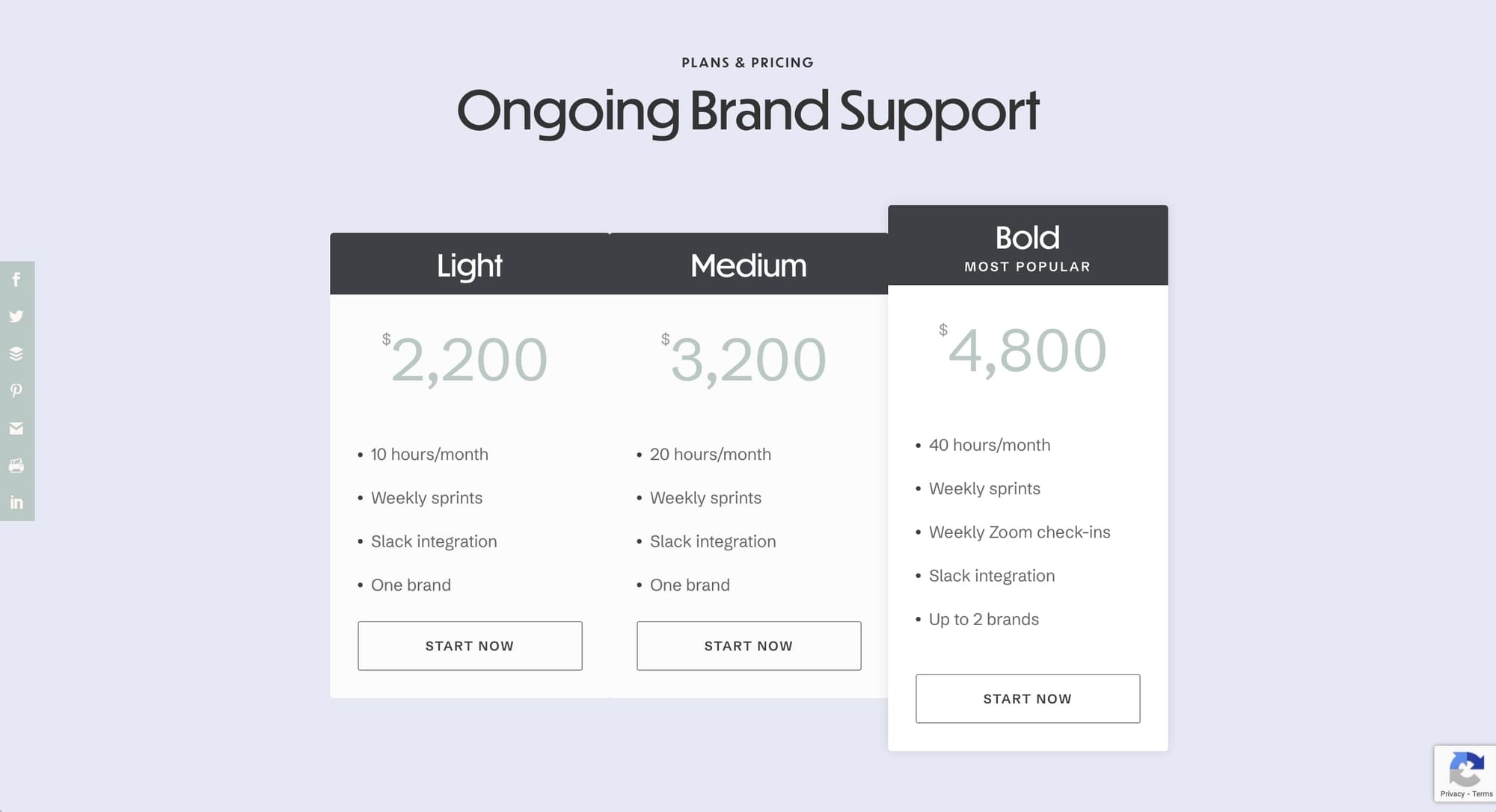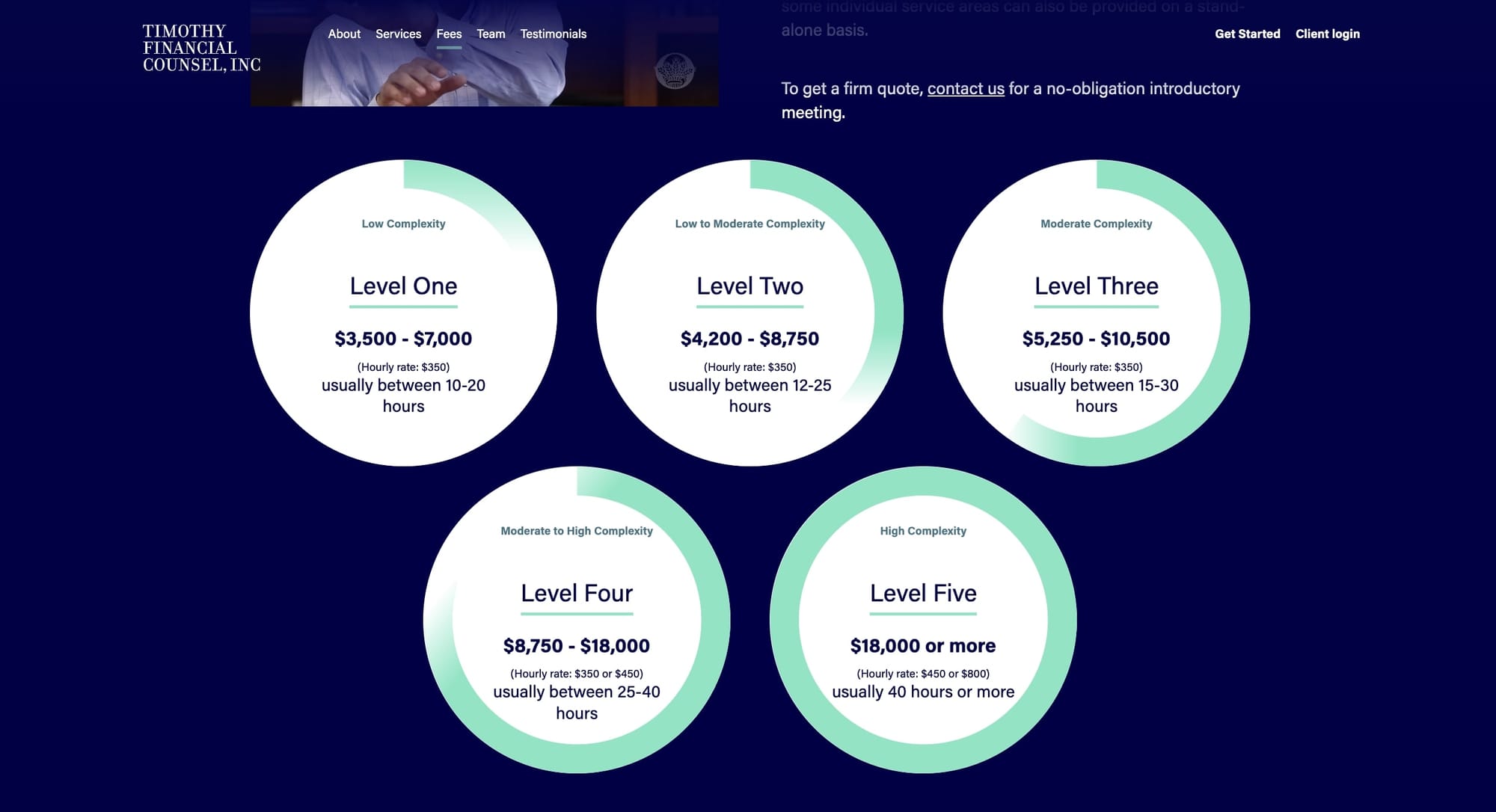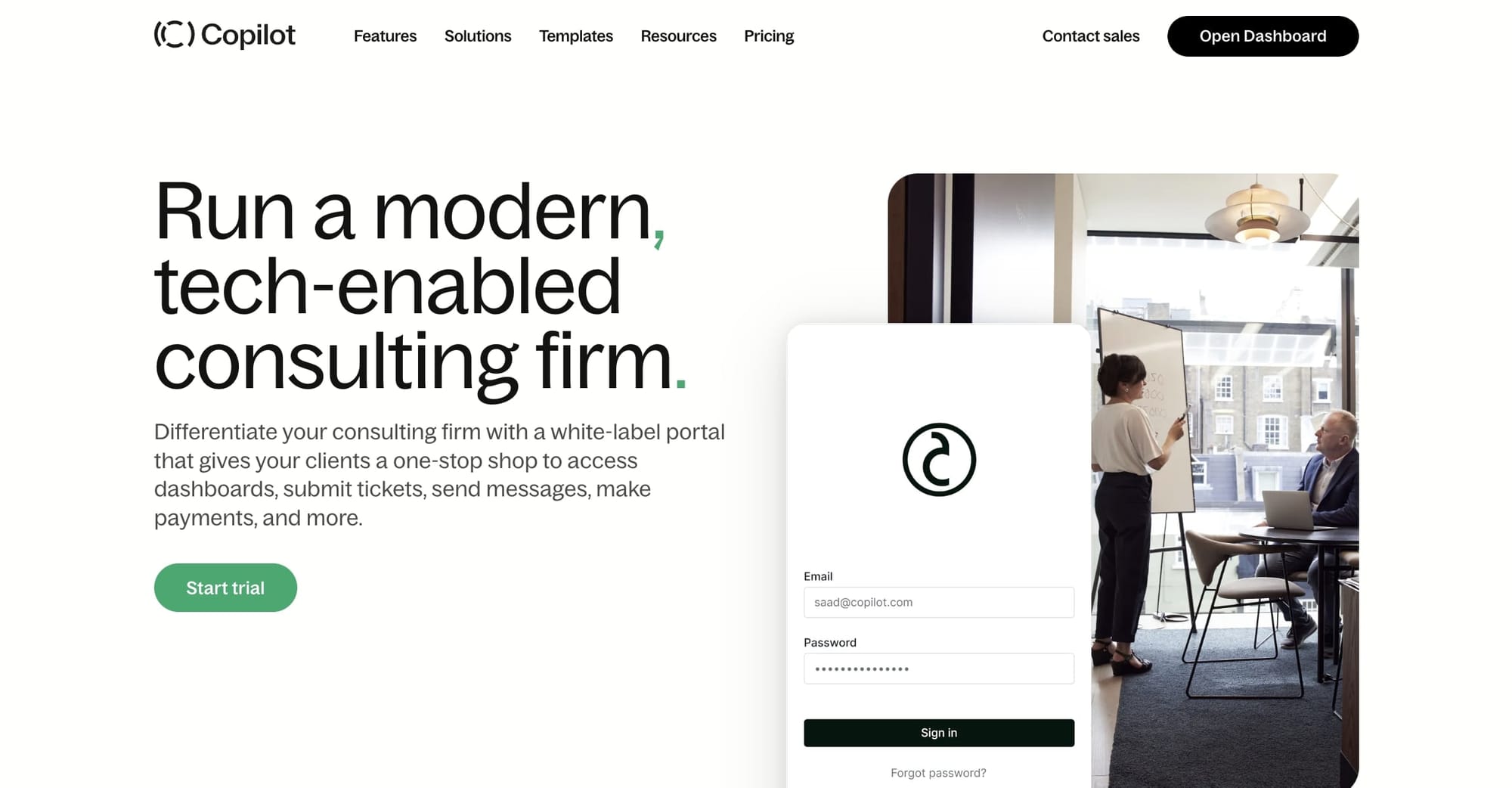
Knowing how to price your consulting services can be the difference between you doing this as a part-time hustle, or as a full-time career that will pay you more than you ever thought possible.
That’s why in this article, I’m going to go over four different consulting pricing models (and their pros and cons) so you can decide how to price your services
Number three is my favorite as it’s the one I personally use with my clients. But, all of these pricing models have their time and place. And I’ll even show website examples from real consultants so you can see how much they charge towards the end of this article.
Alright, I don’t want to waste your time so let’s get right into it.
4 consulting pricing models that work (with pros & cons)
Here are four business models you can use to price your consulting services:
Let’s dive deeper into each of these.
1. Hourly pricing
Hourly pricing is one of the most popular pricing methods for service providers. It’s when you charge your clients for each hour you work — like getting paid by the hour at a regular job.
First, you set a price for your time, say $100 per hour. Then, you keep track of how many hours you spend working for a client — usually done through some time tracking software. At the end, you multiply your hours by your rate to get the total bill that you then invoice to your client.
Pros about hourly pricing:
- It's simple to understand.
- You get paid for all the time you put in.
- It works well for projects that might change or take longer than expected.
Cons about hourly pricing:
- You might earn less if you work quickly (or you’re good at what you do).
- Clients might worry about how many hours you're billing.
- It can be hard to guess the final cost of a project (most set a range to manage client expectations).
Hourly pricing is often good for new consultants or for short-term projects. It's also helpful when you're not sure how long a job will take.
But, if you’re a more experienced consultant, you might want to consider some of the other pricing models on this list. This is because hourly pricing is closely connected to the time you put in. And sometimes the value you can bring to someone does not align with the time it will actually take.
2. Project-based pricing
Project-based pricing is a popular option for consultants who work on a one-off basis. This is when you charge one set price for a whole project, no matter how long it takes you to finish it.
Essentially, you and your client agree on what needs to be done and how much it will cost before you start. For example, you might charge $5,000 to create a social media marketing plan. As we get into a few examples in a later section of this article, you’ll notice that project-based pricing tends to be a popular choice for those in creative fields.
Pros of project-based pricing:
- Clients know exactly how much they'll pay from the start.
- You can earn more if you work efficiently.
- It's easier to show the value of your work, not just your time.
Cons of project-based pricing:
- If the project takes longer than you thought, you might earn less.
- Clients might ask for extra work without wanting to pay more (scope creep).
- It can be tricky to price projects when you're just starting out.
Project-based pricing works well for tasks with clear goals and timelines. It's good for experienced consultants who know how long projects usually take.
3. Subscription or retainer pricing
This model is my favorite, and it’s the one I use for my business. Subscription or retainer pricing means your client pays you a set amount regularly, like every month, for your services. It’s sort of like turning your service business into a SaaS product.
This pricing model is popular among design, web development, and marketing agencies as it helps these firms productize their services and give them more predictable revenue.
In this model, you and your client agree on what services you'll provide and how much they'll pay. For example, you might charge $2,000 per month for 20 hours of work. Or, you could charge a set amount per month for certain deliverables.
Pros of subscription pricing:
- You know how much money you'll make each month
- Clients can budget easily for your services
- It builds long-term relationships with clients
- You can plan your work schedule better
Cons of subscription pricing:
- Some months you might work more or less than planned
- Clients might expect you to be always available
- It can be hard to raise your prices later
Subscription pricing works well for ongoing services, like content creation or business coaching. It's great for consultants who want steady income and long-term clients, which is why I love it so much.
4. Value-based pricing
Value-based pricing means you charge based on the value your work brings to the client, not just your time or effort. Essentially, you only get paid when your client makes money.
You figure out how much money or benefit your work will create for the client. Then, you set your price as a portion of that value. For example, if your work will help a client earn $100,000 more, you might charge $20,000 (20%).
This model tends to work with very experienced consultants who are in specific fields related to high-ticket products. It’s pretty much getting paid based on commissions.
Pros value-based pricing:
- You can earn much more than with other pricing methods.
- It focuses on results, not just your time.
- Clients see your work as an investment, not just a cost.
- It can set you apart from other consultants.
Not-so-good things:
- It can be hard to figure out the exact value of your work.
- Some clients might not understand or like this pricing method.
- You need to be very confident in the results you can deliver.
Value-based pricing works best when you can clearly show how your work will help your client. It's great for experienced consultants who bring a lot of value to their clients' businesses.
How to figure out how much to charge
Setting the right price for your consulting services is a big step in building a successful business. It's not just about picking a number that your competitors have — it's about finding a balance between what you're worth, what the market will bear, and what will help your business grow profitably.
Charging too little might lead to overwork and frustration (which happens to a lot of beginner consultants), while charging too much could scare away potential clients. The key is to consider several important factors and find a sweet spot that works for both you and your clients. Here are 10 essential things to think about when deciding your consulting rates:
- Your experience: If you've been consulting for a long time or have specific knowledge & skills, you can usually charge more. Think about your years in the field and any unique expertise you have. Someone with over a decade of experience in a specific niche will more likely know all of the nuances in an industry, compared with someone who just has a couple of years of experience.
- The market rate: Look at what other consultants in your field charge. This gives you an idea of what clients expect to pay. You can check websites (we’ll get into these in the next section), ask colleagues, or look at industry reports to find this information.
- Your overhead costs: Think about your expenses, like software, office space, or travel. Make sure your prices cover these costs and leave room for profit. Don't forget about taxes and insurance too!
- The value you provide: Consider how much value your work will bring to your client. If you can save them money or time, or make them a lot of money, you will be able to charge more. Try to put a dollar amount on the value you bring.
- Your target clients: Different clients have different budgets. Big companies can usually pay more compared to small businesses or startups. Think about who you want to work with and what they can afford.
- The project complexity: More difficult or time-consuming projects should cost more. Consider the skills needed and how long the project will take.
- Your financial goals: Think about how much money you need to make to support yourself and keep your business alive. Set prices that will help you reach your financial goals.
- Your availability: If you're in high demand, you might be able to charge more. When you have a full schedule, it's often a sign that your prices could go up.
- The length of the project: Long-term projects might have different pricing than short-term ones. You could offer a discount for longer commitments or charge more for quick turnarounds.
- Your location: Prices can be different depending on where you live or where your clients are. Consultants in big cities often charge more than those in smaller towns. However, with the rise of remote work, this may not be a large factor in your pricing decisions.
Remember, it's okay to adjust your prices as you learn more about what works for you and your clients. I’ve done it. What I charge today is not what I charged two years ago. Start somewhere, and don't be afraid to change your prices later if you need to.
3 pricing examples from real consultants
One of the best ways to know how to price your services is to look at real examples. If you have people in your niche who are already selling services and getting clients, it’s a good indicator that there’s money to be made in your niche.
In other words, competitors are a good thing. It helps bring better services to the market.
In a previous article, I went over a handful of websites from different consultants to show examples. Not every consultant shows their prices publicly on their website, but the ones below do.
Here are three examples from real consultants:
Let’s take a look at each of them.
1. Laura Busche

Laura is a consultant who I’ve had the pleasure of working with in the past. What I love about Laura’s approach is that she's leveraged two different pricing models — project-based and subscription-based.
When it comes to project-based pricing, Laura (at the time of writing this) has four brand identity packages. They range anywhere from $750 to $1,700 USD, and each package has its own product landing page that describes everything you’ll get from purchasing it.

Laura also has another set of services that aren’t one-off projects. These services are a part of her “ongoing brand support” services — designed for companies that need a consistent amount of work done per month. This is where the subscription-based pricing model comes into play.
Overall, Laura is a great example of a consultant who has found multiple ways to monetize their skillset. Outside of just services, Laura also sells courses and books — adding even more revenue streams.
Laura’s site is definitely one all individual consultants should learn from.
2. Timothy Financial Counsel

Timothy Financial Counsel is a financial consulting firm whose pricing motto is “Pay only for the time you need — by the hour.” In other words, Timothy Financial Counsel is a great example of an hour-based pricing model.
The great thing about this website is that they set expectations for potential clients on their “Fees” page by showcasing five different pricing tiers, along with a range for how much it would cost based on the hours a client is looking for.
If you’re interested in the hourly pricing model, but you’re not sure how to approach the ranges of hours you may need to charge, this example is one you definitely need to check out.
3. Dara Denney

Dara is a performance creative expert who mainly works with ecommerce brands. Dara is a great example of a consultant who leverages the project-based pricing model.
At the time of writing this, Dara has three packages that range from a consulting call to made-for-you content for social media. This site is very similar to our first example, Laura, in that both consultants have multiple streams of income.
So, if you’re a consultant looking for ways to generate more revenue outside of just working directly with clients, this is a great example to take a look at.
Launch your consulting business with Copilot

Now that you understand different pricing models and how to set your rates, it's time to get your consulting business up and running. Copilot is here to help make that easier for consultants just like you.
Copilot is an all-in-one client portal platform that can help you manage your consulting business from start to finish. Thousands of service providers use the platform to help them with:
- Client management: Keep all your client information in one place. This makes it easy to stay organized and provide great service.
- Invoicing and payment processing: Create professional-looking invoices quickly. You can even set up recurring invoices for your subscription clients.
- Intake forms: Create custom intake forms which can be automated when you onboard new clients.
- Document and contract sharing: Share important files with your clients securely. This is great for sending contracts (including e-signature capabilities) or project deliverables.
- Project Management: While Copilot doesn't have built-in project management, it can connect with different third-party apps like Airtable or ClickUp to help you stay on top of your projects.
- Client experience: Copilot was built with clients in mind. It’s designed to help you create a client experience that leaves your customers feeling like they’re working with a premium consulting firm. This in turn not only helps you keep clients for the long term, but it also helps spread word of mouth about the great experience that comes along with your services.
By using Copilot, you can spend less time on administrative tasks and more time actually consulting. This means you can focus on what you do best — helping your clients and growing your business.
Ready to get started? Sign up for Copilot today (no credit card required) and take the first step towards launching your successful consulting business!
Share this post
Sign up for our newsletter
Subscribe to our newsletter to receive emails about important announcements, product updates, and guides relevant to your industry.
